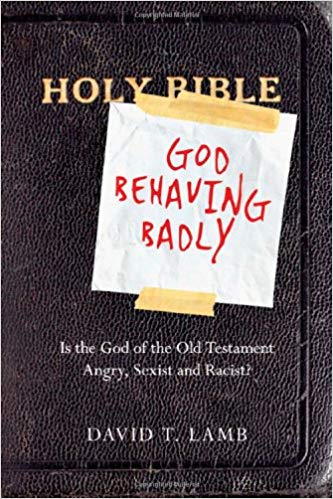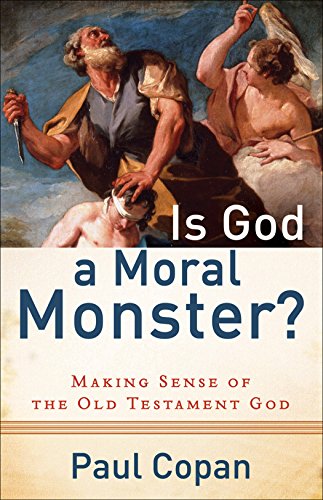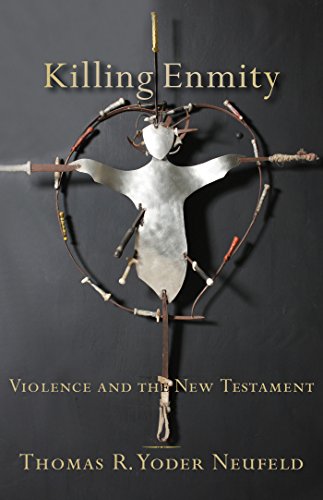God of Anger or God of Love?
God Behaving Badly: Is the God of the Old Testament Angry, Sexist and Racist?
David T. Lamb. 2011. InterVarsity Press, Downers Grove, Illinois. 205 pages.
Is God a Moral Monster? Making Sense of the Old Testament God
Paul Copan. 2011. Baker Publishing Group, Baker Books, Grand Rapids, Michigan. 252 pages.
Killing Enmity: Violence and the New Testament
Thomas R. Yoder Neufeld. 2011. Baker Publishing Group, Baker Academic, Grand Rapids, Michigan. 178 pages.
What kind of God does the Bible portray?
Before New Testament writers recorded their experiences with Jesus Christ, the Hebrew Scriptures alone informed the Church’s understanding of God. But when some began contrasting that Being with Jesus, a very negative image of the Old Testament God developed—an angry demiurge, forever looking for ways to pour out His wrath on a defenseless humanity. Jesus, on the other hand, exuded love, kindness and an ever-patient attitude toward sinful man. Martin Luther, a founding father of the Protestant movement, contributed much to this idea of a divine dichotomy.
David T. Lamb of Biblical Seminary in Pennsylvania thinks modern impressions of the Old Testament God are inaccurate, and in God Behaving Badly he presents another view. He initially appeals to his audience’s sense of political correctness, using emotive terms such as angry, sexist and racist to describe popular concepts of God. If people accept that God possesses characteristics that are unacceptable in today’s society, then they have a case for rejecting the Old Testament God in favor of Christ. But Lamb sets out to show that these notions are distorted and that a fresh look is required.
For example, on the charge that God is an angry being, he counters with Exodus 34:6 and comments that “Yahweh is also said to be ‘merciful,’ ‘gracious’ and ‘abounding in steadfast love and faithfulness.’” Among all these positive descriptors, “one in particular stands out: ‘steadfast love,’ or hesed in the Hebrew. Other translations render hesed as ‘lovingkindness,’ ‘kindness,’ ‘love’ or ‘mercy.’” He remarks that hesed connotes “the best kind of love one could imagine”—the faithful and constant love of a devoted parent or a committed spouse; “it is not a word used lightly for a relationship.” Lamb thus begins to reveal a view of Yahweh, the God of the Old Testament, not generally considered.
In similar fashion he approaches the delicate subject of sexism, remarking that “atheists and secular feminists state unequivocally that God and the Bible are sexist and therefore are responsible for the loathing of women for the past two thousand years.” He points out, however, that both male and female were made in God’s image and argues that the first two chapters of Genesis actually paint a very favorable picture of women. The issue becomes murky when the first humans introduce sin into the equation. God is not the author of sin; He allowed humans to exercise choice, and when they chose to sin, God had to address the fact that sin carries a penalty. But embedded within God’s pronouncement of the price that initial sin would exact from them, writes Lamb, “God declared how he would ultimately defeat the curses through the offspring of the woman.”
After examining other examples of assumed sexism, he concludes: “As more readers and teachers of the Bible emphasize that God affirms women, our culture will realize that Yahweh isn’t sexist. I hope even women who have been victims of sexism will see God not only as the one who created them in his image but also the one who desires [a] relationship with them.”
The author’s appreciation of God’s view of sin is also informative in answering the charge that God is racist. While looking at what is seen as perhaps the most racist account in the Old Testament—God’s instruction to destroy the inhabitants of the land of Canaan—Lamb draws our attention to some important facts that are easily overlooked. First, he says, the land was promised to Abraham and his descendents as early as the time when God selected Abraham to head the family of Israel. Second, in dealing with the Canaanites, God was addressing their extreme wickedness as a nation. From sacrificing children to sorcery to other forms of pagan worship, the land was totally polluted; so God decided to clean the slate to provide a fresh start for Abraham’s descendents. People assume that God’s approach to wickedness is nothing other than anger or racism. Yet this is clearly not the case, because “books like Ruth, Daniel and Jonah reveal Yahweh’s love for non-Israelites; and Israel’s laws commanded the love of foreigners; and genealogies record that loving foreigners is actually loving your own family.”
“How does one reconcile the loving God of the Old Testament with the harsh God of the New Testament? When I ask this question of students, at first they are shocked, and then most assume that I have simply misspoken.”
Is God a Moral Monster?
Like Lamb, Paul Copan digs deep into texts that seem to portray the Old Testament God as full of moral flaws. In Is God a Moral Monster? he declares that he is trying to make sense of this being.
Copan frames his research around neo-atheists’ critiques. While atheism is not new, he points out that there is a new breed of nonbelievers who, especially in the wake of 9/11, are determined to focus attention on the evils done in the name of religion. And while they emphasize “cool-headed, scientific rationality,” Copan suggests that they in fact express themselves in an angry manner. He goes on to note that “the Neo-atheists’ arguments against God’s existence are surprisingly flimsy, often resembling the simplistic village atheist far more than the credentialed academician.” Moreover, he says, they are unwilling to consider the moral atrocities committed by avowed atheists such as Stalin, Pol Pot or Mao Zedong, while continuing to call for Christians to “own up” to all sorts of heinous acts performed in the name of Jesus.
Having thus set the stage, Copan tackles several problematic Old Testament stories and explains where most neo-atheists are led astray and come to wrong conclusions. Contributing to the problem, he says, is a poor understanding of ancient Near East cultures. He stresses that “God’s overarching goal was to bring blessing and salvation to all the nations, including the Canaanites, through Abraham.” With this as a backdrop, he says, events of the Old Testament are easier to comprehend.
For instance, regarding God’s command to sacrifice Isaac, Copan shows that there was abundant positive communication from God to Abraham, and that Abraham couldn’t have missed the signals. He quotes Genesis 22:5: “Abraham said to his young men, ‘Stay here with the donkey; the lad and I will go yonder and worship, and we will come back to you” (emphasis added). Abraham knew that either God would bring Isaac back to life or He would provide him with a different sacrifice.
“Tackling Old Testament ethics is a challenge. Besides a lot of territory to cover, the ancient Near East seems so strange and even otherworldly! We need a good bit of background discussion to help make better sense of this world and of certain Old Testament texts.”
Like Lamb, Copan addresses the killing of the Canaanites as the Israelites entered the Promised Land: “According to Richard Dawkins, the killing of the Canaanites was an act of ethnic cleansing in which ‘bloodthirsty massacres’ were carried out with ‘xenophobic relish.’”
Asking “Were the Canaanites That Wicked?” Copan cites archaeological evidence describing the atrocities committed by and in the name of Canaanite gods and goddesses. Societies reflect the character of their gods, he remarks. He goes on to say that there are many more references to “driving out” or “dispossessing” the Canaanites than to “utterly destroying” them. Copan feels this indicates a gradual removal of the pagan peoples from their land. He discusses some ambiguities in the Hebrew verbs used and points to the fact that there isn’t any archaeological evidence of Canaanites in Israel after 1000 BCE, thus backing up his theory of a gradual removal of the population instead of swift destruction. What God clearly did want to destroy was the religion of the Canaanites and the wickedness it engendered (Deuteronomy 12:2–4).
But what about the neo-atheists’ general charge that religion causes violence? Does belief in a god—whoever it might be—set up an us-versus-them scenario? Does it, by its very nature, lead to a hatred of others’ beliefs and gods, and thus to violence? Copan says the Bible clearly supports tolerance; despite our differences, all human beings are created in the image of God, and believers are to live at peace with everyone as much as they can (Romans 12:18).
In fact, when Israel traveled out of Egypt, a “mixed multitude” went with them, and Yahweh commanded the Israelites to make provisions for these “strangers” among them. If the non-Israelites respected the laws of Yahweh, they were to be treated as native born (Exodus 12:37–38, 48–49).
Copan suggests that religion is often just “the label used to justify violence between warring parties.” But it all should stop when we become more thoughtful about how we apply our faith toward and around others. He concludes, “The God whom the New Atheists consider a monster is not just a holy God to be reckoned with but a loving, self-sacrificing God who invites us to be reconciled to him.”
In these two books, Lamb and Copan provide a thought-provoking look at the God of the Hebrew Scriptures. And while Lamb comes very close to revealing the key to understanding Yahweh as a God of love, his own theological framework prevents it. That simple understanding is provided by the apostle John, who says that “the Word was God” and that “all things were made through Him, and without Him nothing was made that was made” (John 1:1–3). In other words, the Word was none other than Yahweh, who “in the beginning . . . created the heavens and the earth” (Genesis 1:1). John further records that this Word “became flesh and dwelt among us” (John 1:14)—a clear reference to Jesus Christ Himself.
Violence in the New Testament
To this point we have focused on accusations that the God of the Old Testament is violent, whereas, in the words of Thomas R. Yoder Neufeld (Killing Enmity), “the common assumption is that the New Testament is generally against violence.” But he adds that today “what counts as ‘violence’ has widened dramatically, with significant implications” for how the New Testament is viewed.
“As always in our study of texts throughout this book, it matters who is reading, and from where.”
He quotes fellow theologian Robert McAfee Brown: “Whatever ‘violates’ another, in the sense of infringing upon or disregarding or abusing or denying that other, whether physical harm is involved or not, can be understood as an act of violence. The basic overall definition of violence would then become violation of personhood” (Religion and Violence, 1973, 1987).
Based on that broadened definition, Neufeld examines a handful of passages that seem to connote violence in the Apostolic Writings, but his conclusions fail to satisfy. We will focus on just two of his examples here.
First, in a chapter titled “Forgive, or else!” he brings up the parable of the unforgiving servant (Matthew 18:21–35) as a “clash between grace and violence.” It would appear that Neufeld accepts more or less at face value the idea that many of the parables do promote some form of violence. And so he sets out to reconcile what seems, from a critic’s point of view, to be wrong in the message of this particular parable.
Neufeld offers several possible explanations, including defending God by blaming “the highly vindictive tone” of the parable not on Christ but on the person retelling the story, Matthew. That evaluation is at odds, however, with the words of the apostle Paul to his young protégé Timothy: “All Scripture is given by inspiration of God, and is profitable for doctrine, for reproof, for correction, for instruction in righteousness” (2 Timothy 3:16, emphasis added).
What we see in the parable of the unforgiving servant (or slave) is a refusal to forgive to the same extent that he was granted forgiveness. Christ’s point was that if we do not develop a mindset of forgiveness, we will not share in the kingdom of God. The principle of the parable is that we need to treat others the way we want to be treated. If we fail to do that, then we deny ourselves the mercy of God.
The problem underlying Neufeld’s evaluation is the popular idea that God demands nothing of us because Christ’s sacrifice covers everything. The reality of the New Testament message is that even with Christ’s sacrifice, God places demands on our behavior. Right practices, not just belief, are essential (James 1:22; 2:14–26).
In chapter 6, “Subordination and violence,” Neufeld cites passages in Colossians, Ephesians and 1 Peter to address what he calls the “Household Code”—scriptures indicating that the husband is the head of the household, that the wife should submit to him, and that children should obey their parents. Critics, he points out, claim that this leads to vulnerability and violence against the weak. Indeed it can, but Neufeld argues that the Bible in no way condones domestic abuse or violence. He suggests that “the appeal to Christ within the Household Code is to one who precisely does not dominate, who loves the other not only ‘as himself’ but to the extent of giving his life for the liberation of the other.” Paul teaches that the husband should cherish his wife as he does his own flesh. Fathers are supposed to treat their children in a gentle way and not provoke them to anger. Husbands and wives are to submit to each other out of reverence for Christ, whom both are to follow (Ephesians 5:25–33; 1 Peter 3:7; Ephesians 6:4).
The weakness in Neufeld’s approach is that he tends to reduce God’s Word to humanistic terms and evaluates it (and God) on that basis. This results in him often muddying any conclusions he may reach. To judge God within the framework of our own thoughts and definitions is to reduce God to the human level. But God declared through the prophet Isaiah: “My thoughts are not your thoughts, nor are your ways My ways. . . . For as the heavens are higher than the earth, so are My ways higher than your ways, and My thoughts than your thoughts” (Isaiah 55:8).
In the end, Neufeld often comes across as inconclusive and thus unconvinced that the critics are necessarily wrong. If he more confidently allowed the Bible to interpret itself, he might arrive at more clearly defined conclusions.




